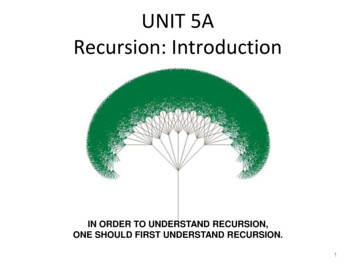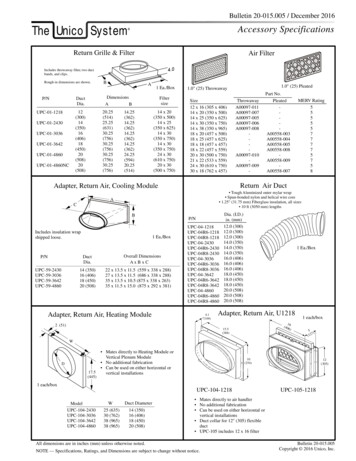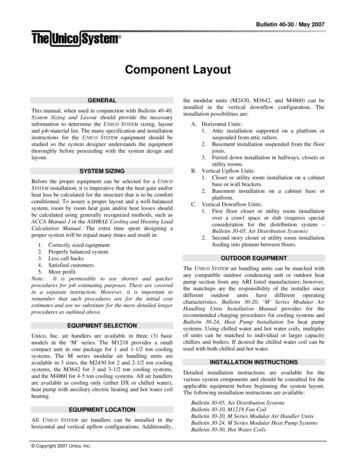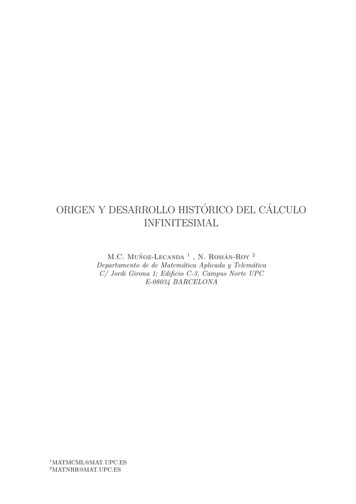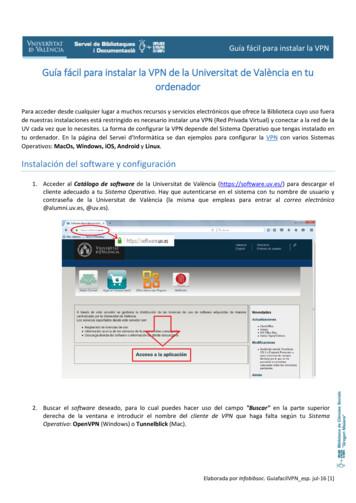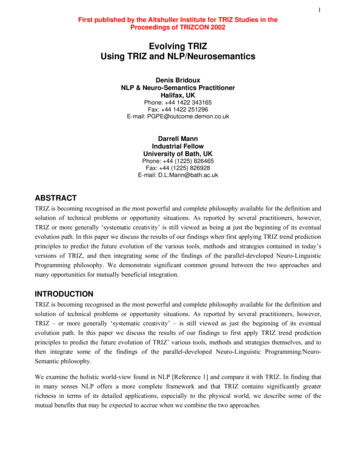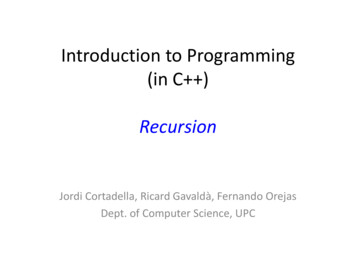
Transcription
Introduction to Programming(in C )RecursionJordi Cortadella, Ricard Gavaldà, Fernando OrejasDept. of Computer Science, UPC
Recursion A subprogram is recursive when it contains a call to itself. Recursion can substitute iteration in program design:– Generally, recursive solutions are simpler than (or assimple as) iterative solutions.– There are some problems in which one solution is muchsimpler than the other.– Generally, recursive solutions are slightly less efficient thanthe iterative ones (if the compiler does not try to optimizethe recursive calls).– There are natural recursive solutions that can be extremelyinefficient. Be careful !Introduction to Programming Dept. CS, UPC2
Factorial// Pre: n 0// Returns n!int factorial(int n) { // iterative solutionint f 1;int i 0;// Invariant: f i! and i nwhile (i n) {i i 1;f f i;}return f;}Introduction to Programming Dept. CS, UPC3
Factorial Definition of factorial:𝑛! 𝑛 𝑛 1 𝑛 2 2 1 Recursive definition:𝑛 𝑛 1 !,𝑛! 1,Introduction to Programming Dept. CS, UPC𝑛 0𝑛 04
Factorial// Pre: n 0// Returns n!int factorial(int n) { // recursive solutionif (n 0) return 1;else return n factorial(n - 1);}Introduction to Programming Dept. CS, UPC5
Recursive designIn the design of a recursive program, we usually follow asequence of steps:1. Identify the basic cases (those in which the subprogram cansolve the problem directly without recurring to recursivecalls) and determine how they are solved.For example, in the case of factorial, the only basic case usedin the function is n 0. Similarly, we could have considered amore general basic case (e.g., n 1). In both cases, thefunction should return 1.Introduction to Programming Dept. CS, UPC6
Recursive design2. Determine how to resolve the non-basic cases in terms of thebasic cases, which we assume we can already solve.In the case of a factorial, we know that the factorial of anumber n greater than zero is n factorial(n-1).3. Make sure that the parameters of the call move closer to thebasic cases at each recursive call. This should guarantee afinite sequence of recursive calls that always terminates.In the case of a factorial, n-1 is closer to 0 than n. Therefore,we can guarantee that this function terminates.Introduction to Programming Dept. CS, UPC7
Recursive design For example, it is not clear whether the following functionterminates:// Pre: n 1// Returns the number of steps of the Collatz sequence// that starts with n.int Collatz(int n) { // recursive solutionif (n 1) return 0;else if (n%2 0) return 1 Collatz(n/2);else return 1 Collatz(3 n 1);} The reason is that 3 n 1 is not closer to 1 than nIntroduction to Programming Dept. CS, UPC8
Recursion: behind the scenes.f factorial(4);.int factorial(int n)4if (n4 1) return 1;3else return n4 factorial(n-1);int factorial(int n)3if (n3 1) return 1;2else return n3 factorial(n-1);int factorial(int n)2if (n2 1) return 1;1else return n2 factorial(n-1);int factorial(int n)1if (n1 1) return 1;else return n1 factorial(n-1);Introduction to Programming Dept. CS, UPC9
Recursion: behind the scenes.f factorial(4);24.24 factorial(int n)int4if (n4 1) return 1;24 63else return n4 factorial(n-1);6 factorial(int n)int3if (n3 1) return 1;6 22else return n3 factorial(n-1);2 factorial(int n)int2if (n2 1) return 1;2 11else return n2 factorial(n-1);1 factorial(int n)int1if (n1 1) return 1;else return n1 factorial(n-1);Introduction to Programming Dept. CS, UPC10
Recursion: behind the scenes Each time a function is called, a new instance ofthe function is created. Each time a function“returns”, its instance is destroyed. The creation of a new instance only requires theallocation of memory space for data (parametersand local variables). The instances of a function are destroyed inreverse order to their creation, i.e. the firstinstance to be created will be the last to bedestroyed.Introduction to Programming Dept. CS, UPC11
Write the binary representationDesign a procedure that, given a number n, writes itsbinary representation.// Pre: n 0// Post: the binary representation of has been written.void base2(int n) { Basic case (n 1) write “1” General case (n 1) write n/2 and then write n%2Introduction to Programming Dept. CS, UPC12
Write the binary representation// Pre: n 0// Post: the binary representation of n has been written.void base2(int n) {if (n 1) cout n;else {base2(n/2);cout n%2;}}The procedure always terminates since n/2 is closer to 1 than n.Note that n/2 is never 0 when n 1. Therefore, the case n 1will always be found at the end of the sequence call.Introduction to Programming Dept. CS, UPC13
Fibonacci numbers Design a function that, given a number n, returns theFibonacci number of order n.The Fibonacci numbers are:order 0fib11234567891235813213455 In general, except for n 0 and n 1, the Fibonacci number oforder n is equal to the sum of the two previous numbers.Introduction to Programming Dept. CS, UPC14
Fibonacci numbers// Pre: n 0// Returns the Fibonacci number of order n.int fib(int n); Basic case:n 0 Return 1.n 1 Return 1. General case:n 1 Return fib(n - 1) fib(n - 2)Introduction to Programming Dept. CS, UPC15
Fibonacci numbers// Pre: n 0// Returns the Fibonacci number of order n.int fib(int n) { // Recursive solutionif (n 1) return 1;else return fib(n - 2) fib(n - 1);}The function always terminates since the parameters of therecursive call (n-2 and n-1) are closer to 0 and 1 than n.Introduction to Programming Dept. CS, UPC16
Fibonacci numbersThe tree of calls for fib(5) would ction to Programming Dept. CS, UPC17
Fibonacci numbers When fib(5) is calculated:––––––fib(5) is called oncefib(4) is called oncefib(3) is called twicefib(2) is called 3 timesfib(1) is called 5 timesfib(0) is called 3 times When fib(n) is calculated, how many times willfib(1) and fib(0) be called? Example: fib(50) calls fib(1) and fib(0) about2.4·1010 timesIntroduction to Programming Dept. CS, UPC18
Fibonacci numbers// Pre: n 0// Returns the Fibonacci number of order n.int fib(int n) { // iterative solutionint i 1;int f i 1;int f i1 1;// Inv: f i is the Fibonacci number of order i.//f i1 is the Fibonacci number of order i-1.while (i n) {int f f i f i1;f i1 f i;f i f;i i 1;}return f i;}Introduction to Programming Dept. CS, UPC19
Fibonacci numbers With the iterative solution, if we calculatefib(5), we have that:– fib(5) is calculated once– fib(4) is calculated once– fib(3) is calculated once– fib(2) is calculated once– fib(1) is calculated once– fib(0) is calculated onceIntroduction to Programming Dept. CS, UPC20
Counting a’s We want to read a text represented as a sequence ofcharacters that ends with ‘.’ We want to calculate the number of occurrences of theletter ‘a’ We can assume that the text always has at least onecharacter (the last ‘.’) Example: the textProgramming in C is amazingly easy !.has 4 a’sIntroduction to Programming Dept. CS, UPC21
Counting a’s// Input: a sequence of characters that ends with ‘.’// Returns the number of times ‘a’ appears in the// sequence (and the sequence has been read) Basic case:We have a ‘.’ at the input return 0 General case:We have something different from ‘.’ at the input calculate the number ofremaining ‘a’ at the input and add 1 if the current char is an ‘a’Introduction to Programming Dept. CS, UPC22
Counting a’s// Input: a sequence of characters that ends with ‘.’// Returns the number of times ‘a’ appears in the// sequence (and the sequence has been read)int count a() {char c;cin c;if (c '.') return 0;else if (c 'a') return 1 count a();else return count a();}Even though it has no parameters, we can see that the functionterminates if we consider that the input is an implicit parameter. At everyrecursive call, a new char is read. Therefore, each call moves closer toreading the final dot.Introduction to Programming Dept. CS, UPC23
Tower of Hanoi The puzzle was invented by the French mathematician Édouard Lucas in 1883.There is a legend about an Indian temple that contains a large room with threetime-worn posts in it, surrounded by 64 golden disks. To fulfil an ancient prophecy,Brahmin priests have been moving these disks, in accordance with the rules of thepuzzle, since that time. The puzzle is therefore also known as the Tower of Brahmapuzzle. According to the legend, when the last move in the puzzle is completed,the world will end. It is not clear whether Lucas invented this legend or wasinspired by it.(from http://en.wikipedia.org/wiki/Tower of Hanoi) Rules of the puzzle:–––A complete tower of disks must be movedfrom one post to another.Only one disk can be moved at a time.No disk can be placed on top of a smaller disk.Not allowed !Introduction to Programming Dept. CS, UPC24
Tower of HanoiIntroduction to Programming Dept. CS, UPC25
Tower of HanoiIntroduction to Programming Dept. CS, UPC26
Tower of Hanoi What rules determine the next move? How many moves do we need? There is no trivial iterative solution.Introduction to Programming Dept. CS, UPC27
Tower of HanoiInductive reasoning: assume that we know how to solve Hanoi for n-1 disks Hanoi(n-1) from left to middle (safe: the largest disk is always at the bottom) Move the largest disk from the left to the right Hanoi(n-1) from the middle to the right (safe: the largest disk is always at the bottom)Introduction to Programming Dept. CS, UPC28
Tower of Hanoi// Pre://// Post://n is thefrom, toTower offrom pegnumber of disks (n 0).and aux are the names of the pegs.Hanoi solved by moving n disksfrom to peg to using peg auxvoid Hanoi(int n, char from, char to, char aux) {if (n 0) {Hanoi(n - 1, from, aux, to);cout “Move disk from “ from “ to “ to endl;Hanoi(n - 1, aux, to, from);}}Introduction to Programming Dept. CS, UPC29
Tower of Hanoi// Main program to solve the Tower of Hanoi// for any number of disksint main() {int Ndisks;// Read the number of diskscin Ndisks;// Solve the puzzleHanoi(Ndisks, ‘L’, ‘R’, ‘M’);}Introduction to Programming Dept. CS, UPC30
Tower of Hanoi Hanoi5Move diskMove diskMove diskMove diskMove diskMove diskMove diskMove diskMove diskMove diskMove diskMove diskMove diskMove diskMove omfromfromfromIntroduction to oveMoveMoveMoveMoveMoveMoveMoveMove Dept. CS, ototototototototototototototoRLRRLMLLRRMMRLRR31
Tower of HanoiHanoi(0,L,M,R)Hanoi(1,L,R,M)L RHanoi(0,M,R,L)Hanoi(2,L,M,R)L MHanoi(2,L,M,R)Hanoi(0,R,L,M)Hanoi(1,R,M,L)R MHanoi(0,L,M,R)Hanoi(3,L,R,M)L RHanoi(0,M,R,L)Hanoi(1,M,L,R)M LHanoi(0,R,L,M)Hanoi(2,M,R,L)M RHanoi(2,M,R,L)Hanoi(0,L,M,R)Hanoi(1,L,R,M)L RHanoi(0,M,R,L)Introduction to Programming Dept. CS, UPC32
Tower of HanoiHanoi(0,L,M,R)Hanoi(1,L,R,M)L RHanoi(0,M,R,L)Hanoi(2,L,M,R)L MHanoi(0,R,L,M)Hanoi(1,R,M,L)R MHanoi(0,L,M,R)Hanoi(3,L,R,M)L RHanoi(0,M,R,L)Hanoi(1,M,L,R)M LHanoi(0,R,L,M)Hanoi(2,M,R,L)M RHanoi(0,L,M,R)Hanoi(1,L,R,M)L RHanoi(0,M,R,L)Introduction to Programming Dept. CS, UPC33
Tower of Hanoi How many moves do we need for n disks?Moves(n) 1 2 Moves(n-1)n Moves(n)112337415531663n2n-1Introduction to Programming Dept. CS, UPC34
Tower of Hanoi Let us assume that we canmove one disk every second. How long would it take tomove n disks?Introduction to Programmingn1510152025time1s31s17m 3s9h 6m 7s12d 3h 16m 15s1y 23d 8h 40m 31s30405060 34y 34,000y 35,000,000y 36,000,000,000y Dept. CS, UPC35
Digital root The digital root (or the repeated digital sum) of anumber is the number obtained by adding all thedigits, then adding the digits of that number, andthen continuing until a single-digit number isreached. For example, the digital root of 65536 is 7, because6 5 5 3 6 25 and 2 5 7.Introduction to Programming Dept. CS, UPC36
Digital root Basic case: n can be represented as a singledigit number return n General case: n has more than one digit– Calculate the sum of the digits– Calculate the digital root of the sumIntroduction to Programming Dept. CS, UPC37
Digital root// Assume we have a function (to be defined)// that calculates the sum of the digits of a number// Pre: n 0// Returns the sum of the digits of n// (represented in base 10)int sumdigits(int n);// Pre: n 0// Returns the digital root of nint digital root(int n) {if (n 10) return n;else return digital root(sumdigits(n));}Introduction to Programming Dept. CS, UPC38
Write a number n in base b Design a program that writes a number n inbase b. Examples:1024 is 10000000000110122126621024Introduction to Programming Dept. CS, UPCininininbasebasebasebase2371039
Write a number n in base b Basic case: n 0 do not write anything(avoid writing numbers with a leading 0). Treatthe zero as a special case outside the function. General case: n 0– Write the leading digits of the number (n/b)– Write the last digit of the number (n%b)Introduction to Programming Dept. CS, UPC40
Write a number n in base b// Writes the representation of n in base b (n 0, 2 b 10)// No digits are written when n 0.void write base(int n, int b) {if (n 0) {write base(n/b, b);cout n%b;}}// Input: read two numbers, n and b, with n 0 and 2 b 10// Output: write the representation of n in base b.int main() {int n, b;cin n b;if (n 0) cout “0”;else write base(n, b);cout endl;}Introduction to Programming Dept. CS, UPC41
Introduction to Programming (in C ) Recursion Jordi Cortadella, Ricard Gavaldà, Fernando Orejas Dept. of Computer Science, UPC. Recursion A subprogram is recursive when it contains a call to itself. Recursion can substitute iteration in program design:
